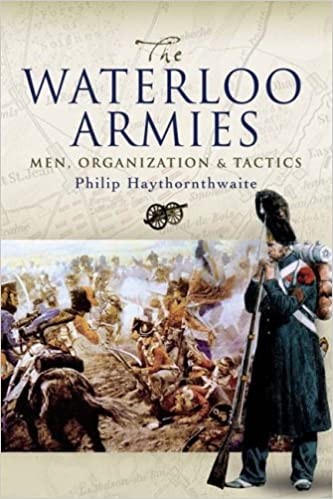Philip Haythornthwaite is a prolific author and historical consultant specializing in the military history, uniforms and equipment of the 18th and 19th centuries. Waterloo is one of the most famous battles in history and it has given rise to a vast and varied literature. But the organization, structure and fighting strength of the armies that fought in the battle have received little attention, and this is the subject of Philip Haythornthwaite’s detailed study.
Reader’s Review
by Thomas Zacharis, independent scholar
Another new book on the Battle of Waterloo on 18 June 1815, which marked the end of the period of wars of the first French Empire. The book contains comprehensive information and charts on the military units that participated in the battle, namely the French, British, German, Dutch-Belgian and Prussian. The author colours his book with pictures of distinctive figures and soldiers, as well as with prints of the battle’s main commanders from the author’s private collection, excepting pages 24 and 25 respectively. The book also includes two lists: one presenting the strength and casualties of each army during the battle, and one presenting each army’s order of battle. What distinguishes this book from an ordinary military book that would refer to the forces and number of divisions of each rival army in a battle are the recollections and dialogues of the soldiers and officers who fought in the Battle of Waterloo. Haythornwaite gives a detailed description of the story of each unit, one-by-one, which took part in the battle, up until the level of the regiment together with the squadron of their commanders. He also describes the battle formations used during that period by those armies. Between his descriptions of the history and action of each unit, the author inserts witty military remarks. One such example is the remark by Wellington on the French Cuirassiers, stating that Napoleon used them “as a kind of accelerated infantry”. He also finds an opportunity to rectify some past historical mistakes, like the claim that the final attack of the French imperial guard was led by the third and fourth regiment of the old guard, whereas in actual fact they belonged to the “middle” guard. He also repairs the damaged reputation of the King of the Netherlands, Prince William II of Orange, regarding the destruction of the 69th British regiment at Quatre Bras, for which the officer of the regiment Major Herny Lidsay was also responsible; similarly, the responsibility for the destruction of the 5th Battalion of the King’s German Legion at the Battle of Waterloo was also attributed to Sir Charles Alten, who led them to the attack. Another figure that caught Haythornwaite’s attention was the commander of the 3rd Netherlands Division, Lieutenant-General David Henri Baron Chassé, also known by the nickname of “General Bayonet”, and the role that his division played in dealing with the French imperial guard. Haythornwaite’s descriptive analysis does not leave out the support units such as the mechanics and medical services. He pays special attention to the Baron Dominique – Jean Larrey, a great surgeon and humanitarian. Larrey was wounded during the retreat and taken prisoner by the Prussian Cavalry, and he was almost executed as they confused him with Napoleon. He was recognised by a Prussian surgeon who had once attended one of his lectures. He was then taken to Blücher, who held him in the highest esteem, since Larrey had tended to Blücher’s wounded son in 1813. As Napoleon said, he was a remarkable person. Haythornwaite succeeds by using the story of the units and their commanders to recreate the Battle of Waterloo, to its very last detail, a battle in which Napoleon’s ambitiousness, the French army’s desire for democracy, Blücher’s hatred for Napoleon, and most of all the sense of duty of Lord Wellington and the British army all fought in a bloody battle that marked the end of an historical period. All readers who are interested in the Battle of Waterloo will find in this book the most accurate guide to exploring the battle step-by-step.


